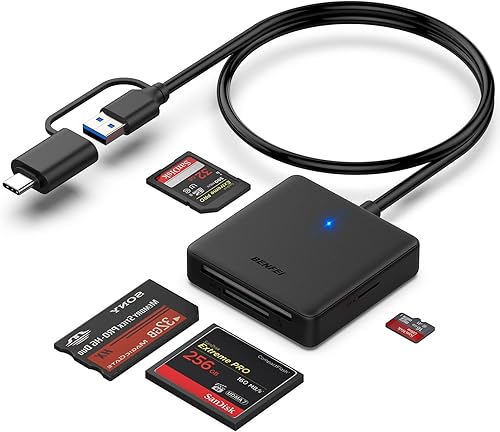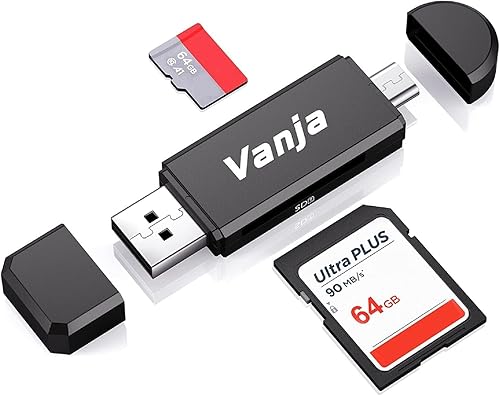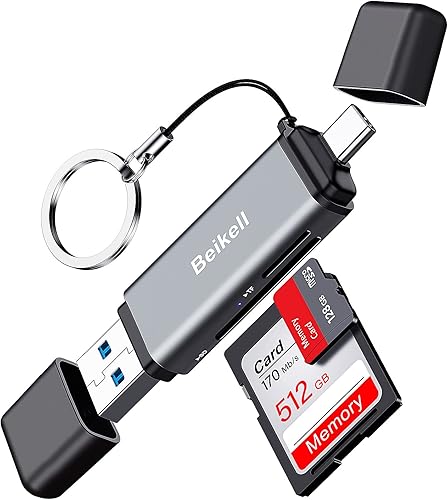How to Choose an External Memory Card Reader in 2025? Guide and Comparison
External memory card readers are essential tools for photographers, videographers, and anyone who regularly manages digital data. Whether it's transferring images, videos, or other files, selecting a reader that suits your needs will optimize transfer speed and compatibility with various devices. This guide aims to help you choose the ideal memory card reader.
Our TOP 3
BENFEI

Pros
- Simultaneous access to multiple types of cards
- Fast transfer up to 160 MB/s
- Good compatibility with various devices
Cons
- No support for SDXC cards with older systems
Specs
Vanja

Pros
- Extended compatibility with many card formats
- Portable and durable design
- Advanced OTG functionalities
Cons
- Not compatible with iPhone/iPad
Specs
Selection Criteria
Supported Card Types
First, identify the types of cards you need to read regularly. The most common card formats include SD (Secure Digital), microSD, CF (CompactFlash), and XQD. A good reader should be compatible with all the cards you plan to use, at a minimum SD and microSD, which are the most ubiquitous.
Transfer Speed
Transfer speed is crucial, particularly for processing large files like 4K videos. USB 3.0 card readers and above, such as USB 3.1 and USB-C, offer significantly faster rates than USB 2.0 models. Opt for USB-C if you work with modern devices to benefit from enhanced transfer speeds.
Operating System Compatibility
Ensure the card reader is compatible with the operating systems you use, whether it's Windows, macOS, or Linux. Most readers do not require additional drivers, especially if they follow Plug-and-Play standards.
Design and Portability
Consider design and portability based on your usage. A compact and lightweight model is ideal for frequent travel. Some readers include a retractable USB cable to reduce clutter. Additionally, a sturdy casing provides better protection during travel.
Power Supply
Most memory card readers are USB-powered, eliminating the need for an external power source, but it's crucial to confirm this feature to avoid any surprises.
Common Mistakes
Neglecting Transfer Speed
Choosing a card reader with insufficient speed can slow down your workflow. For a USB 3.0 reader to express its full potential, it must be connected to a compatible USB 3.0 port on the computer.
Forgetting to Check Card Compatibility
Ensure all card types you use are supported. New formats such as UHS-II or UHS-III often require a compatible reader to maximize speed.
Ignoring System Compatibility Specifics
Some readers may not work properly with certain operating systems or might require additional drivers, which could pose problems for plug-and-play use.
Comparison of our 3 favorite products
BENFEI- Multi-format card support with universal compatibility

The BENFEI memory card reader offers versatile and fast access to different cards with its USB-C and USB 3.0 connections. It is ideal for those looking to use multiple types of memory cards on modern devices.
Pros
- Broad compatibility with USB-C/USB 3.0 devices
- High transfer speed
- Simultaneous access to multiple cards
Cons
- Some SDXC cards require an updated system
Vanja- Micro USB interface with OTG functionality

The Vanja reader is designed for users who need to connect memory cards directly to devices compatible with Micro USB and OTG. Compact and easy to transport, it is perfect for travel.
Pros
- OTG accessibility
- Portable and durable design
- Supports a wide range of card formats
Cons
- Not compatible with iPhone/iPad
Beikell- Ultra-fast transfer speed with USB 3.0

The Beikell card reader allows extremely fast data transfers thanks to its USB 3.0 interface. With a robust aluminum build, it is also compatible with many devices, offering both efficiency and durability.
Pros
- Transfer speed up to 5 Gbps
- Solid aluminum construction
- Plug and play, supports simultaneous access to two cards
Cons
Practical Tips
Plan for Scalability
Choosing a reader capable of handling the latest formats, such as UHS-II, ensures some longevity in the face of future memory card developments.
Regularly Test Performance
It is wise to periodically check transfer times and proper reader functionality to ensure hardware and software remain compliant.
Optimize Storage
Use a protective case to carry your card reader to prevent physical damage and extend its lifespan.